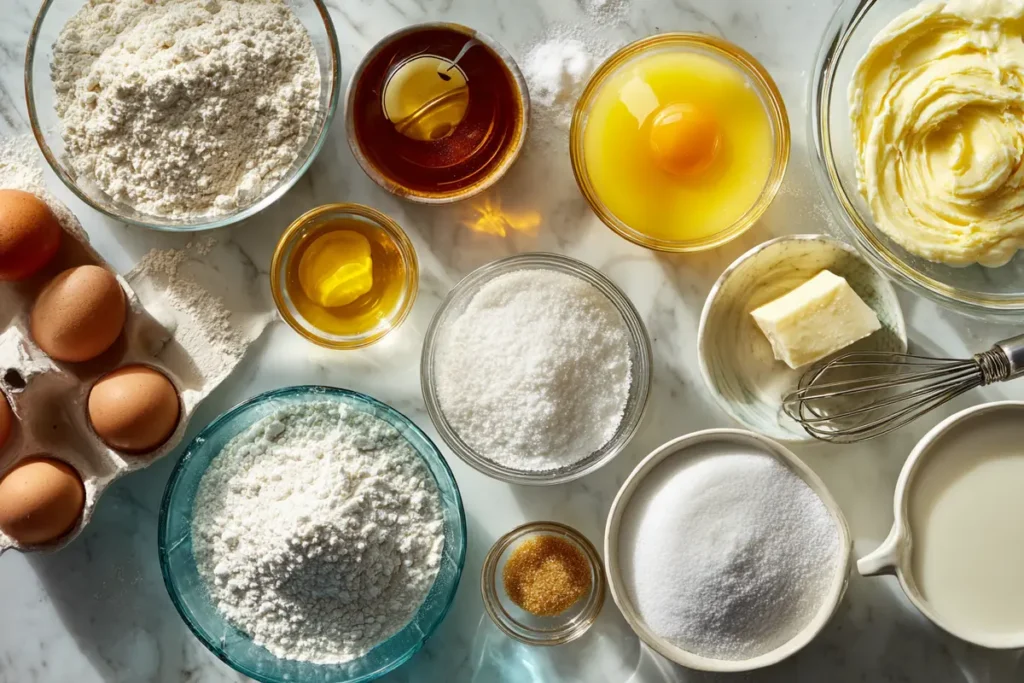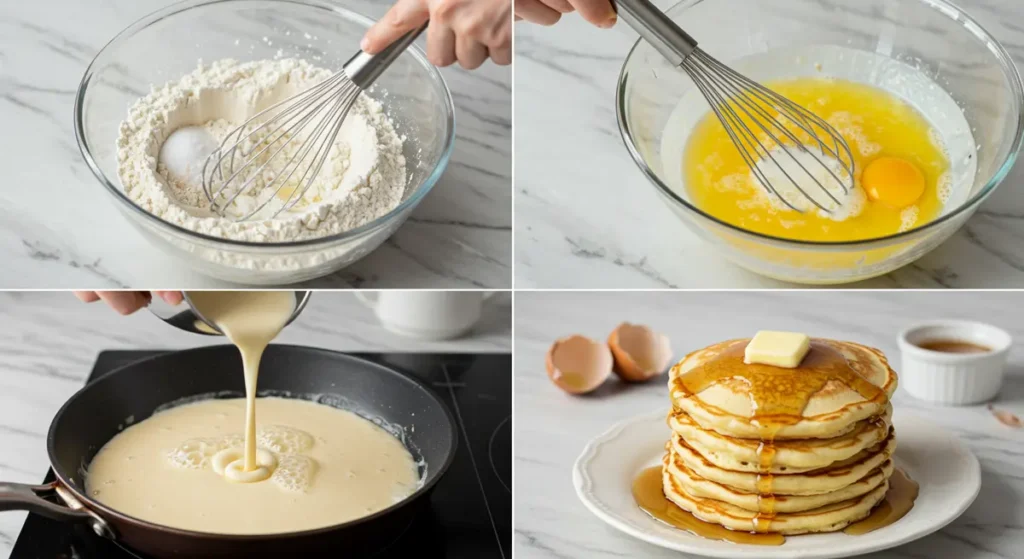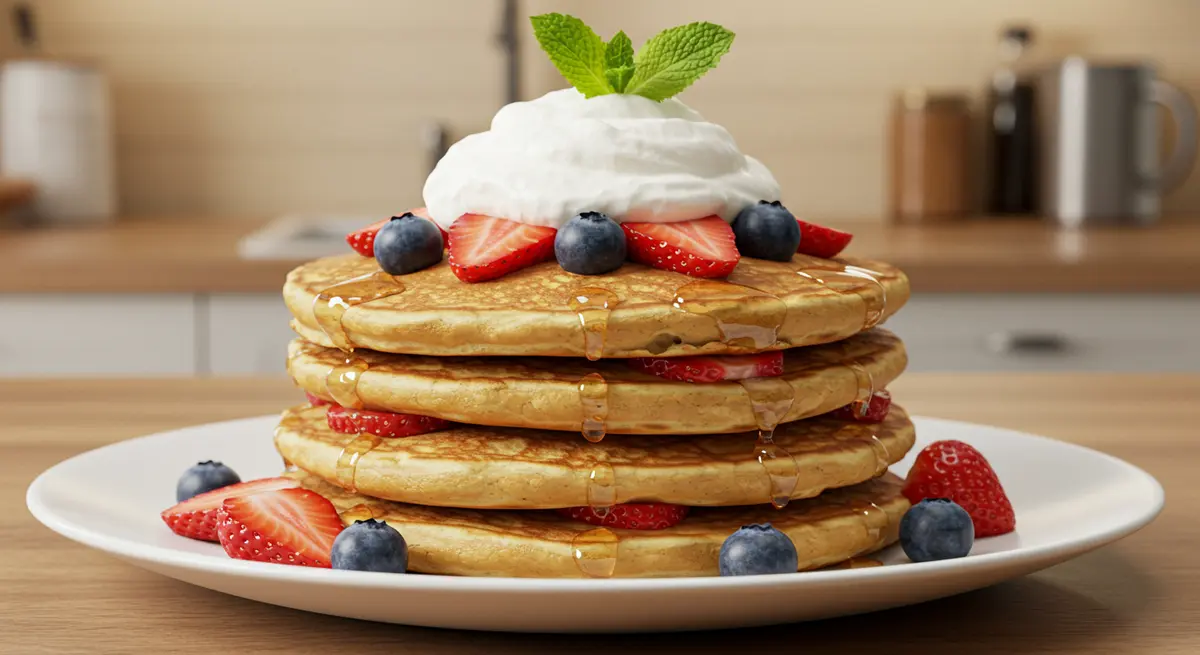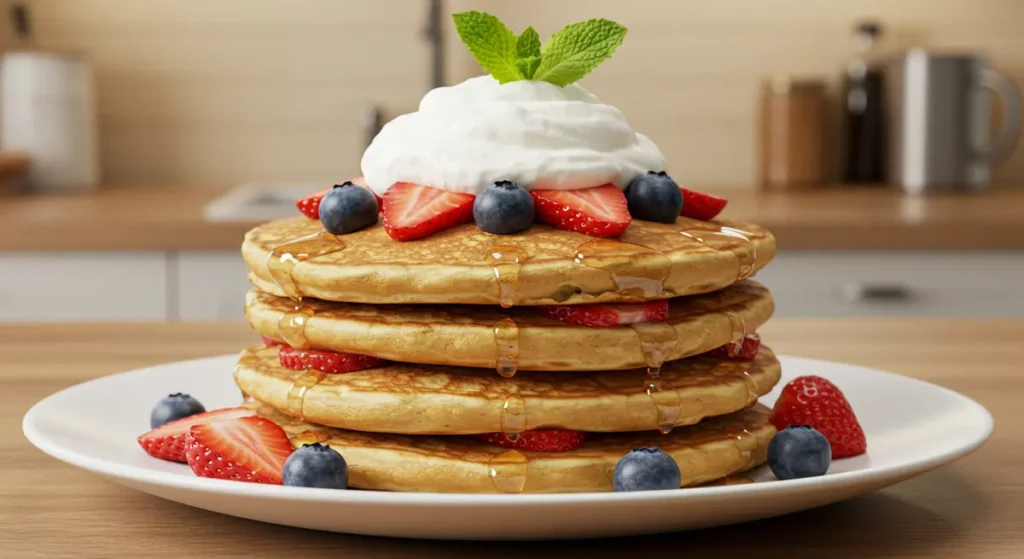Nothing says cozy mornings and weekend comfort quite like a warm stack of fluffy pancakes—and if there’s one recipe that stands out for its simplicity, consistency, and rich flavor, it’s the famous Martha Stewart pancake recipe. Known for turning everyday meals into elegant experiences, Martha has built her name around reliable, delicious food. Her pancake recipe is no exception—loved for its ease, taste, and fluffy texture.
In this complete guide, you’ll discover the story behind the Martha Stewart pancake recipe, the exact ingredients, step-by-step instructions, and tips to make your pancakes golden and irresistible. Whether you’re new to pancakes or just want to upgrade your brunch game, this recipe delivers perfection every time.
The Story Behind the Martha Stewart Pancake Recipe
Who is Martha Stewart and Why Her Pancake Recipe Went Viral
Martha Stewart is more than a celebrity chef—she’s an American culinary icon. Her ability to take classic recipes, refine them, and make them accessible has made her a household name. Among her most beloved breakfast dishes is the Martha Stewart pancake recipe, which became a go-to for home cooks seeking that perfect balance between airy texture and buttery flavor.
When Martha first shared this pancake recipe on her show and online platforms, it quickly caught fire. People loved how easy it was to follow and how incredible the pancakes turned out. With just a few basic ingredients and her signature technique, fluffy pancakes were now within reach for everyone—from beginners to seasoned brunch hosts.
The appeal isn’t just in the outcome; it’s in the process. The Martha Stewart pancake recipe is designed to work with what you already have in your kitchen, yet it yields café-style pancakes that feel gourmet.
Origins and Evolution of Her Classic Pancake Recipe
The original Martha Stewart pancake recipe draws from traditional American buttermilk pancakes, but with tweaks that make it distinctly hers. Martha refined the formula to use just the right proportions of flour, baking powder, sugar, and milk, along with perfectly beaten eggs and melted butter.
Over time, this recipe evolved through fan feedback and creative spins shared on social media. Variants emerged—think banana pancakes, blueberry-packed stacks, and even protein-rich versions for fitness lovers—all inspired by the original. But at its core, the Martha Stewart pancake recipe remains a beloved staple: simple to make, hard to beat, and always a crowd-pleaser.
Ingredients Used in Martha Stewart’s Pancake Recipe
Essential Pantry Staples in the Recipe
One of the standout qualities of the Martha Stewart pancake recipe is its simplicity. With just a few common ingredients, you can whip up a batch of pancakes that feel anything but ordinary. Here’s what you’ll need for the traditional version:
| Ingredient | Quantity | Purpose |
|---|---|---|
| All-purpose flour | 1 ½ cups | Base structure of the batter |
| Baking powder | 3 ½ teaspoons | Leavening for fluffiness |
| Salt | 1 teaspoon | Enhances flavor |
| Granulated sugar | 1 tablespoon | Adds a touch of sweetness |
| Milk | 1 ¼ cups | Liquid for moisture and consistency |
| Egg | 1 large | Binds the ingredients together |
| Unsalted butter | 3 tablespoons, melted | Richness and flavor |

These are the backbone of the Martha Stewart pancake recipe, creating light and airy pancakes with golden edges and a soft interior. Using fresh ingredients—especially baking powder and eggs—can make a noticeable difference in both flavor and texture.
If you want to double the batch for a family breakfast, the recipe scales beautifully. Just make sure to maintain the correct ratios between dry and wet ingredients.
Substitutions and Variations: Dairy-Free, Gluten-Free, or Healthy Twists
One reason why the Martha Stewart pancake recipe continues to trend is its flexibility. It’s easy to customize based on dietary needs without compromising texture or taste.
Here are some popular substitutions:
| Ingredient to Replace | Alternative Option | Effect on Flavor/Texture |
|---|---|---|
| All-purpose flour | Gluten-free flour blend | Slightly denser but still fluffy |
| Milk | Almond milk, oat milk, or soy milk | Lighter flavor; oat milk works best |
| Egg | Mashed banana or flaxseed egg | Adds a touch of sweetness or nuttiness |
| Butter | Coconut oil or plant-based butter | Offers a hint of coconut or neutral fat |
For health-conscious eaters, consider reducing the sugar or using whole wheat flour for added fiber. You can even add ingredients like chia seeds or rolled oats for texture.
Want to make them heartier? Try adding Greek yogurt or cottage cheese to the batter—these boost protein content and add a slight tang that complements maple syrup perfectly.
Step-by-Step Instructions for Martha Stewart Pancakes
Preparing the Batter: Mixing Techniques for Fluffiness
The secret behind the unmatched texture of the Martha Stewart pancake recipe is all in the batter prep. The goal? A smooth, lump-free mix that isn’t overworked. Here’s how to do it step by step:
- Sift the Dry Ingredients
In a large bowl, sift together the all-purpose flour, baking powder, salt, and sugar. Sifting ensures the dry ingredients are evenly distributed and helps avoid clumps. - Whisk the Wet Ingredients Separately
In another bowl, whisk together the milk, egg, and melted butter until fully combined. Don’t skip this step—it ensures the fats and liquids blend smoothly before they hit the flour. - Combine Gently
Make a well in the center of the dry ingredients, then pour in the wet mixture. Use a spatula or wooden spoon to gently fold everything together. A few small lumps are totally fine—overmixing will develop gluten and lead to tough pancakes. - Let the Batter Rest (Optional but Recommended)
For best results, let your batter rest for 5–10 minutes. This allows the flour to hydrate and the leavening agents to begin activating, creating fluffier results.

Cooking Tips: Temperature, Flipping, and Timing
Getting pancakes just right on the stove is all about patience and knowing when to flip. Follow these tips to make the most of the Martha Stewart pancake recipe:
- Preheat Your Pan or Griddle
Heat a non-stick skillet or griddle over medium heat. If using butter or oil, wipe off any excess with a paper towel. You want the surface lightly greased, not sizzling with fat. - Portion with Precision
Use a ¼-cup measuring cup for uniform pancake sizes. This helps them cook evenly and stack beautifully. - Wait for the Bubbles
After pouring the batter, wait until bubbles form across the surface and the edges start to firm up—usually about 2–3 minutes. That’s your signal to flip. - Flip Only Once
Carefully slide a spatula under the pancake and flip it in one smooth motion. Cook the second side for 1–2 minutes or until golden brown. - Keep Warm
If cooking in batches, place finished pancakes on a baking sheet in a 200°F oven to keep them warm until serving.

These techniques ensure your Martha Stewart pancake recipe turns out light, golden, and cooked evenly every single time. Even beginners will feel confident flipping like a pro!
Tools and Equipment You’ll Need
Best Pans and Griddles for Pancakes
While you can technically make pancakes in any pan, using the right cookware elevates the Martha Stewart pancake recipe from good to flawless. Martha herself recommends a heavy-bottomed non-stick skillet or a large electric griddle for maximum surface area and even heat distribution.
| Tool | Why It Works |
|---|---|
| Non-stick skillet | Prevents sticking and allows easy flipping |
| Cast iron skillet | Retains heat well; great for a crispy edge |
| Electric griddle | Cooks multiple pancakes at once; consistent heat |
When cooking with a skillet, medium heat is your friend. Too hot and your pancakes will burn before the inside cooks; too low and they’ll be pale and underdone. Electric griddles are especially useful for making large batches—they maintain a steady temperature and offer space to cook three to four pancakes simultaneously.
Kitchen Tools to Make the Process Smoother
The Martha Stewart pancake recipe is easy to follow, but having the right tools makes the process even more enjoyable—and consistent. These are the kitchen must-haves that will help you whip up the perfect stack:
| Tool | Use in Recipe |
|---|---|
| Mixing bowls (2) | One for dry, one for wet ingredients |
| Whisk | Blends wet ingredients thoroughly |
| Spatula or wooden spoon | Gently folds batter without overmixing |
| Measuring cups/spoons | Ensures accurate ingredient ratios |
| ¼-cup scoop or ladle | Keeps pancake sizes uniform |
| Thin spatula/flipper | Eases flipping without tearing the pancake |
| Cooling rack (optional) | Prevents steaming when stacking warm pancakes |
Pro tip: If you’re feeding a crowd, preheat your oven to 200°F and line a baking sheet with parchment. After cooking, transfer each pancake to the oven to keep them warm without drying them out.
Using quality tools won’t just improve your results—it’ll make you want to recreate the Martha Stewart pancake recipe again and again.
Common Mistakes to Avoid When Making Martha Stewart Pancakes
Even with a legendary guide like the Martha Stewart pancake recipe, there’s room for error. Avoiding these common pitfalls can mean the difference between rubbery flapjacks and fluffy, golden perfection.
Why Your Pancakes Turn Out Flat or Rubbery
One of the biggest disappointments for any pancake lover is cutting into a stack that’s flat, chewy, or dry. Luckily, these problems are easy to fix when you understand the cause.
- Overmixing the Batter
The #1 mistake? Stirring too much. Overmixing activates the gluten in the flour, leading to dense and rubbery pancakes. The Martha Stewart pancake recipe calls for gentle folding—stop as soon as the flour disappears. - Using Expired Leavening Agents
Old baking powder doesn’t rise properly. Always check the date before adding it to your dry mix. A fresh leavening agent is key to achieving that airy lift. - Wrong Temperature
If your skillet is too hot, pancakes burn on the outside while staying raw in the center. Too cold? They’ll absorb oil and stay pale. Stick to medium heat and adjust as needed. - Skipping the Batter Rest
Letting the batter sit for 5–10 minutes gives the flour time to hydrate and helps the baking powder activate fully. This short pause makes a big difference. - Inconsistent Pancake Sizes
Uneven sizes mean uneven cooking. Use a ¼-cup scoop or ladle to make each pancake uniform and easier to flip.
Fixing Texture and Flavor Issues
So, your pancakes didn’t turn out quite right—no worries. Here’s how to troubleshoot and recover:
- Too Dense?
Double-check your baking powder and avoid heavy flours. Next time, try sifting the dry ingredients for better aeration. - Too Flat?
You may need more leavening, or your batter might be too runny. Add a tablespoon of flour and stir gently. - Bland Flavor?
Don’t be afraid to add a pinch more salt or sugar. Also, using real butter and fresh milk makes a noticeable difference. - Uneven Cooking?
Clean the pan between batches. Burnt bits from previous pancakes can affect heat distribution and taste.
Avoiding these slip-ups keeps the Martha Stewart pancake recipe true to its delicious, fluffy promise every time you use it.

Martha Stewart Pancake Recipe: The Ultimate Step-by-Step Guide to Fluffy Perfection
Ingredients
Method
- In a large bowl, sift together flour, baking powder, salt, and sugar.
- In a separate bowl, whisk the milk, egg, and melted butter.
- Pour the wet ingredients into the dry mixture. Stir gently until combined (a few lumps are okay).
- Let the batter rest for 5–10 minutes.
- Heat a non-stick skillet or griddle over medium heat and lightly grease.
- Pour ¼ cup batter for each pancake. Cook until bubbles form on top, then flip.
- Cook the other side until golden brown, about 1–2 minutes.
- Serve warm with toppings of choice.
Nutrition
Notes
- For fluffier pancakes, let the batter rest before cooking.
- Swap milk for almond or oat milk for a dairy-free version.
- To freeze: Stack with parchment paper between pancakes and store in an airtight bag for up to 2 months.
Tried this recipe?
Let us know how it was!Nutritional Breakdown of Martha Stewart Pancakes
Calories, Protein, Carbs, and Fat per Serving
If you’re keeping an eye on your nutrition, it’s helpful to know what’s inside each serving of the Martha Stewart pancake recipe. Below is the typical breakdown for one standard pancake (about 4–5 inches in diameter), based on the original recipe using whole milk and butter:
| Nutrient | Amount per Pancake |
|---|---|
| Calories | ~125 |
| Total Fat | 5.2g |
| Saturated Fat | 2.8g |
| Carbohydrates | 17g |
| Sugars | 3g |
| Protein | 3.2g |
| Sodium | 220mg |
| Fiber | 0.5g |
These values can vary based on ingredient brands, serving sizes, or added toppings like syrup, fruit, or chocolate chips. While the Martha Stewart pancake recipe is indulgent and comforting, it offers balanced macronutrients that can be adjusted depending on your health goals.
How to Make It Healthier While Keeping the Taste
Want a lighter take on the Martha Stewart pancake recipe? With a few smart swaps, you can reduce the calorie count and boost nutritional value without sacrificing flavor.
| Ingredient Swap | Why It Works |
|---|---|
| Whole wheat flour for white flour | Adds fiber and protein, reduces glycemic load |
| Almond milk for whole milk | Lowers calories and fat content |
| Greek yogurt (in place of butter) | Reduces saturated fat, adds protein and creaminess |
| Mashed banana (instead of sugar) | Natural sweetness plus potassium and fiber |
Other health-conscious upgrades include adding chia seeds or flaxseed to increase omega-3s and fiber. You can also top your pancakes with fresh berries instead of syrup for natural sweetness and antioxidants.
Even with these changes, the pancakes retain their light, tender texture—making it possible to enjoy the Martha Stewart pancake recipe on a daily basis if you’d like, without guilt.
Perfect Toppings and Add-Ons for Martha Stewart Pancakes
Fresh Fruits, Syrups, and Creative Toppings
A classic stack of pancakes is satisfying on its own, but toppings elevate the experience—especially when following the Martha Stewart pancake recipe. Her base recipe is intentionally neutral, making it ideal for both sweet and savory add-ons. Whether you love traditional maple syrup or bold flavor combos, here are some must-try toppings:
Sweet Toppings
| Topping | Why It Works |
|---|---|
| Pure maple syrup | A classic companion with rich depth |
| Fresh berries | Adds color, antioxidants, and a tart contrast |
| Sliced bananas | Offers creaminess and natural sweetness |
| Whipped cream | Light, fluffy texture to match the pancake base |
| Nutella or chocolate spread | Dessert-like indulgence that melts on warm cakes |
| Honey and cinnamon | Earthy, warm flavor without processed sugar |

Martha herself often recommends lightly dusting pancakes with powdered sugar or adding a fruit compote—especially for holiday brunches. You can even drizzle melted butter for that old-school diner-style finish.
Savory Pancake Topping Ideas You Didn’t Think Of
Savory pancakes? Absolutely. The Martha Stewart pancake recipe makes a wonderful canvas for unique, non-sweet toppings that surprise and satisfy. Here are some gourmet-worthy options:
Savory Toppings
| Topping | Flavor Profile |
|---|---|
| Fried egg + avocado | Rich, creamy, and satisfying |
| Smoked salmon + cream cheese | Elegant and brunch-worthy |
| Crumbled bacon + maple drizzle | Sweet and salty perfection |
| Sauteed mushrooms + herbs | Earthy and aromatic |
| Shredded cheese + hot sauce | Spicy and bold flavor burst |
To create a brunch spread, mix sweet and savory toppings to please every palate. These creative combinations turn the simple Martha Stewart pancake recipe into a gourmet breakfast centerpiece, perfect for weekend entertaining or breakfast-for-dinner nights.
Serving Ideas: When and How to Serve Martha Stewart Pancakes
Breakfast, Brunch, or Dessert Options
The beauty of the Martha Stewart pancake recipe is its versatility—it fits effortlessly into any meal plan. Whether you’re serving a quick weekday breakfast or hosting an elaborate Sunday brunch, these pancakes deliver a warm, homemade touch.
Breakfast
Start your morning with two or three hot-off-the-skillet pancakes, served with a dab of butter and a drizzle of maple syrup. Add scrambled eggs and fresh fruit on the side for a complete, energizing meal. For kids, consider fun shapes made with pancake molds or a topping bar with mini bowls of chocolate chips, sprinkles, and fruit.
Brunch
When it comes to brunch, presentation counts. Stack the pancakes tall, top them with fresh berries, and serve with mimosas or cold brew. You can prep the Martha Stewart pancake recipe ahead of time and warm them in the oven just before serving. Pair with quiche, sausage links, or a yogurt parfait for variety.
Dessert
Yes, pancakes can double as dessert! Serve a small stack topped with vanilla ice cream, caramel drizzle, and crushed nuts. You can even roll them into crepes and fill them with mascarpone or jam for an elegant twist on after-dinner sweets.
Creative Presentation Tips for Family or Guests
Elevating the look of your pancakes doesn’t require a culinary degree. With these simple tricks, even a casual morning meal can feel like a special occasion:
- Use a Cake Stand or Tiered Platter
Stack your pancakes high and dust with powdered sugar for a bakery-style display. - Individual Servings on Small Plates
Create mini stacks with unique toppings for each guest—great for brunch parties. - Add Garnishes
Mint leaves, citrus zest, or a drizzle of berry coulis take the presentation to the next level. - Warm Plates Before Serving
A warm plate keeps pancakes from cooling too fast and feels more polished.
With a few thoughtful touches, the Martha Stewart pancake recipe can be dressed up or down to suit any setting, from casual breakfasts to photo-worthy brunch spreads.
Comparison: Martha Stewart’s Pancake Recipe vs Other Celebrity Chefs
What Sets Her Pancakes Apart from Gordon Ramsay or Joanna Gaines
The Martha Stewart pancake recipe stands out for its simplicity, accessibility, and reliability. But how does it compare to other celebrity chefs known for their take on breakfast favorites?
Let’s take a look:
| Chef | Recipe Style | Key Difference from Martha Stewart |
|---|---|---|
| Gordon Ramsay | High-end technique, uses crème fraîche and buttermilk | More complex, richer flavor, harder to replicate |
| Joanna Gaines | Southern-inspired, often includes vanilla or nutmeg | Sweeter profile, often denser in texture |
| Ree Drummond | Heartier portions, butter-heavy, often adds fruit | Adds flair but sometimes overpowers pancake base |
| Ina Garten | Uses ricotta or lemon zest for a gourmet twist | Lighter and tangier, suited for special occasions |
What makes Martha Stewart’s pancake recipe a favorite is its balance—fluffy but not too airy, flavorful but not overly rich, and customizable without needing fancy ingredients. Unlike Ramsay’s layered techniques or Ina Garten’s upscale variations, Martha’s method is built for everyday home cooks looking for consistency.
It’s this dependable, down-to-earth approach that’s earned her pancakes a loyal following.
Reader Taste Test and Poll: Which Recipe Wins?
To get real feedback, we ran a casual taste test among a group of home cooks and food enthusiasts. Each prepared pancake recipes from Martha Stewart, Gordon Ramsay, and Joanna Gaines, using ingredients found at their local grocery stores.
Here’s how the favorites ranked based on taste, texture, and ease of preparation:
| Chef | Average Score (out of 10) | Most Loved Feature |
|---|---|---|
| Martha Stewart | 9.2 | Light, fluffy, easy to follow |
| Joanna Gaines | 8.3 | Sweet, comforting, great with syrup |
| Gordon Ramsay | 7.5 | Rich flavor but technique-intensive |
Most participants praised the Martha Stewart pancake recipe for being beginner-friendly and nearly foolproof, making it ideal for both everyday mornings and special occasions. It came out on top in terms of taste, texture, and time efficiency—a rare combination that’s tough to beat.
Frequently Asked Questions (FAQ)
u003cstrongu003eWhat makes Martha Stewart’s pancake recipe unique?u003c/strongu003e
The u003cstrongu003eMartha Stewart pancake recipeu003c/strongu003e stands out for its simplicity, reliability, and texture. It uses pantry staples but achieves a consistently fluffy, golden-brown pancake without needing any specialty equipment or ingredients. Her step-by-step process is designed for home cooks of all levels.
u003cstrongu003eCan I make Martha Stewart pancakes ahead of time?u003c/strongu003e
Yes, you can make the batter ahead and refrigerate it for up to 24 hours. Alternatively, cook the pancakes and store them in an airtight container in the fridge for 2–3 days. Reheat in a toaster or oven to maintain their fluffiness and crisp edges.
u003cstrongu003eAre there gluten-free or vegan options?u003c/strongu003e
Absolutely. You can substitute all-purpose flour with a 1:1 gluten-free flour blend and use plant-based milk like oat or almond. Replace the egg with a flaxseed egg (1 tbsp ground flax + 3 tbsp water) and use coconut oil instead of butter for a completely vegan version of the u003cstrongu003eMartha Stewart pancake recipeu003c/strongu003e.
u003cstrongu003eHow thick should the pancake batter be?u003c/strongu003e
The ideal batter consistency for the u003cstrongu003eMartha Stewart pancake recipeu003c/strongu003e is thick but pourable. It should slowly drip off a spoon, not run like water or stick like dough. If it’s too thick, add a tablespoon of milk at a time; if too thin, sprinkle in a little flour.
u003cstrongu003eCan I freeze leftover pancakes?u003c/strongu003e
Yes, these pancakes freeze exceptionally well. After cooking, let them cool, then stack with parchment paper between each layer. Freeze in a zip-top bag for up to 2 months. Reheat in a toaster, microwave, or oven for a quick breakfast anytime.
u003cstrongu003eWhat’s the best topping for these pancakes?u003c/strongu003e
Classic maple syrup is a favorite, but Martha also recommends fresh berries, whipped cream, or even a dollop of yogurt. For a fun twist, try sautéed apples with cinnamon, or a drizzle of almond butter and honey.
Conclusion: Bring the Martha Stewart Pancake Recipe to Your Table
From its effortless method to its perfectly fluffy results, the Martha Stewart pancake recipe continues to be a staple in American kitchens—and for good reason. Whether you’re craving a cozy weekday breakfast, hosting brunch, or trying a new weekend treat, this recipe never fails to deliver.
We’ve explored every angle—from the origin of the recipe to common cooking mistakes and delicious topping ideas. You’ve seen how it compares to other famous chefs and how easy it is to customize for health, dietary needs, or flavor preferences.
In short, this isn’t just a recipe—it’s a go-to breakfast tradition. With a few simple ingredients and Martha’s timeless technique, you can flip pancakes like a pro and serve them up with pride.
